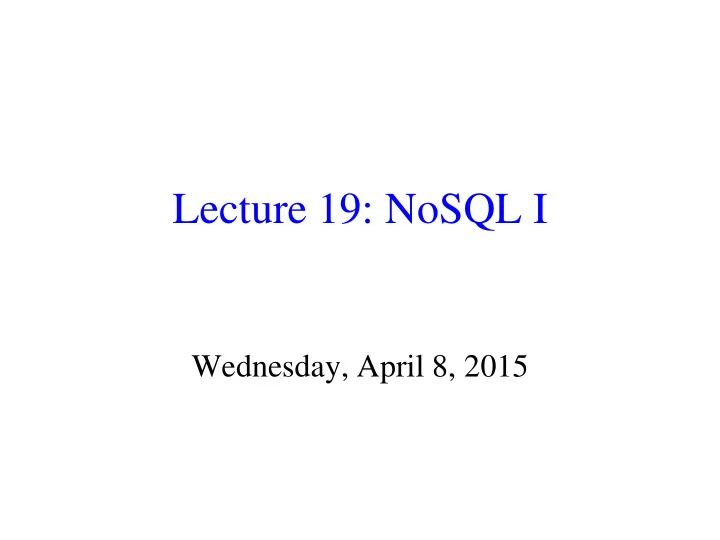

Lecture 19: NoSQL I Wednesday, April 8, 2015
Where We Are • Mostly done with class project (phase 2 is optional) • Today: Big Data • Next class: MapReduce & Pig • Next Wed: Cloud platforms • In 2 weeks: MongoDB & other Data Stores • In 3 weeks: Prep for Final Very important: Keep up with readings and tutorials: • Sadalage and Fowler, NoSQL Distilled (Addison-Wesley, 2013) • MongoDB video tutorials (links on course web site)
Source: UC Berkeley AMP Lab
Source: UC Berkeley AMP Lab
Source: UC Berkeley AMP Lab
“Big Data” • Just a buzzword? • Gartner 2011 report*: – High volume – High variety – High velocity Question: what do you think about “Big Data”? * http://www.gartner.com/newsroom/id/1731916
“Big Data” is really two problems • The analysis problem: – How to extract useful info, using aggregate queries, machine learning and statistics • The storage problem: – How to organize and partition huge amounts of data to support interactive queries
“Big Data” Meets RDBMS Source: Sloan Digital Sky Survey images obtained from http://skyserver.sdss.org
Classical DBMS (“Elephant” systems) • Fixed schema (but alterations are possible) • High-level query language (i.e. SQL) • Limited analytics • Structured & persistent data (e.g. inventory, banking, payroll, etc.) • ACID properties • Query optimization for consistent workloads • Complex install & configurations • Consumes time to load data • Limited clustering and fault tolerance • Primitive data partitioning technology • Prohibitively expensive at web scale
Parallel Architectures Performance metrics: speedup v.s. scaleup Challenges: communication, resource contention, data skew
Discussion of Readings What is the “impedance mismatch” problem? Source: Sadalage and Fowler, NoSQL Distilled (Addison-Wesley, 2013).
NoSQL Systems • Name “NoSQL” = “Not SQL” or “Not Only SQL” • Typical characteristics: • don't use relational model • “flexible” schema => implicit schema • unstructured and semi -structured data • simple APIs (no joins) • eventual consistency (=> immature consistency) • mostly open-source systems • easy to prototype and deploy • designed for use on clusters • support for data partitioning and replication • Major forces driving NoSQL systems: • cloud platforms (will come back to this topic) • web 2.0 apps
“Data Systems” Landscape Source: Lim et al, “How to Fit when No One Size Fits”, CIDR 2013.
DBMS Market Shares • From 2011 Gartner report*: – Oracle: 48% market with $11.7BN in sales – IBM: 20% market with $4.8BN in sales – Microsoft: 17% market with $4.0BN in sales – Other vendors (i.e. NoSQL): 5.8% market with $1.3BN in sales * http://www.gartner.com/newsroom/id/1731916
Discussion of Readings • NoSQL taxonomy proposed by Sadalage and Fowler: – Analytics: MapReduce, Pig, Hive, Spark, Dremel – Key/Value: Redis, Memcached, Voldemort – Column: BigTable, DynamoDB, HBase, Cassandra – Document: CouchDB, MongoDB, SimpleDB – Graph: GraphDB, Neo4j • “NewSQL” or Hybrid Systems: – Megastore, Spanner, F1, VoltDB, NuoDB
Optional References The Unreasonable Effectiveness of Data [Alon Halevy et. al., IEEE Intelligent Systems 24(2): 8-12, 2009] Challenges and Opportunities with Big Data – A community white paper developed by leading researchers across the United States. [D. Agrawal et al., http://cra.org/ccc/docs/init/bigdatawhitepaper.pdf, Mar 2012] The elephant in the room: getting value from Big Data [ACM Sigmod Blog. http://wp.sigmod.org/?p=1519, Feb 2015]
Next Class • MapReduce and Pig • HW 4
Recommend
More recommend